
The threadfin rainbowfish or featherfin rainbowfish is a rainbowfish, the only species in the genus Iriatherina. It is characterized by long beautiful fins, and is among the most attractive of the rainbowfishes.

Rainbowfishes are small, colourful freshwater fishes belonging to the family Melanotaeniidae, found in northern and eastern Australia, New Guinea, Sulawesi and Madagascar.
Cairnsichthys is a genus of rainbowfishes from the subfamily Melanotaeniinae. The genus is endemic to freshwater streams in eastern Queensland in north eastern Australia. The genus was designated as a monotypic genus in 1928 by John T. Nichols and Henry C. Raven but in 2018 a second species was assigned to the genus.

Melanotaenia is a genus of rainbowfish from Australia, Indonesia, New Guinea, and nearby smaller islands.

The Lake Eacham rainbowfish is a species of rainbowfish in the subfamily Melanotaeniidae which was thought to be endemic to Yidyam, Queensland, Australia but has proven to have a wider range.
Ogilby's rainbowfish is a species of rainbowfish in the subfamily Melanotaeniinae. It is endemic to West Papua in Indonesia in the Lorentz River system. This species was described in 1910 by Max C.W. Weber from types collected in the Noord-Fluss, now renamed the Lorentz River, by the Dutch explorer Hendrikus Albertus Lorentz in 1907, it was not recorded again until Gerald R. Allen collected more specimens in 1995 and the species was later introduced to the aquarium hobby. Its specific name honours the ichthyologist James Douglas Ogilby (1853-1925).
The honey blue-eye is an endangered species of fish in the subfamily Pseudomugilinae. It is endemic to southeastern Queensland, Australia, where it is found in mildly acidic, often tannin-stained, ponds and streams in wallum habitat.
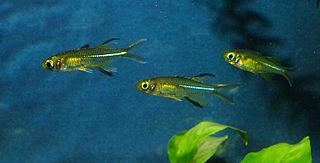
The Celebes rainbowfish is a species of sailfin silverside endemic to Sulawesi in Indonesia. It is the only known member of its genus.
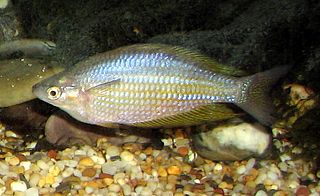
Melanotaenia splendida splendida, also known as the eastern rainbowfish, is a subspecies of fish in the family Melanotaeniidae endemic to Australia.
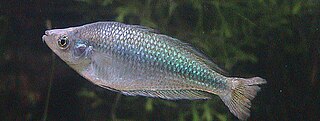
The Murray River rainbowfish, known less commonly as the Australian rainbowfish, is a species of freshwater fish endemic to southeastern Australia. The southernmost species of all rainbowfishes, these fish are very colourful, hence the name; and there is sexual dimorphism with the males being larger and more colourful than females. Murray River rainbowfish are schooling fish and will congregate near logs or riverbanks, and are a popular aquarium fish.

Chaetodontoplus duboulayi, the scribbled angelfish, is a species of marine ray-finned fish, a marine angelfish belonging to the family Pomacanthidae. This species is from the southwestern Pacific Ocean.

The ornate rainbowfish is a species of rainbowfish endemic to an area in eastern Australia, where it is native to coastal regions and sandy offshore islands in southern Queensland and northern New South Wales. It is the only known member of its genus. It is a popular aquarium fish.

The black-banded rainbowfish is a species of rainbowfish belonging to the subfamily Melanotaeniidae. The species is endemic to Australia. Importantly, the species is the type species of the genus Melanotaenia.
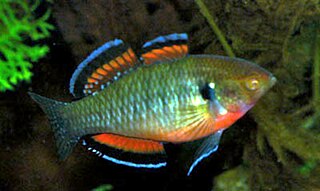
Hypseleotris compressa, the empire gudgeon, is a species of Gobiiform fish in the family Eleotridae endemic to Australia and south-central New Guinea.

The Pacific blue-eye is a species of fish in the subfamily Pseudomugilinae native to eastern Australia. Described by Austrian naturalist Rudolf Kner in 1866, it comprises two subspecies that have been regarded as separate species in the past and may be once again with further study. It is a common fish of rivers and estuaries along the eastern seaboard from Cape York in North Queensland to southern New South Wales, the Burdekin Gap in central-north Queensland dividing the ranges of the two subspecies.
Ambassis marianus, commonly known as the estuary perchlet, Ramsay's glassfish, estuary glassfish or glass perchlet, is a species of fish in the family Ambassidae. It is native to coastal eastern Australia. It gains its common name from its transparent appearance.

Melanotaeniinae the Australian rainbowfishes is a subfamily of the rainbowfishes of the family Melanotaeniidae. They are a group of small, colourful, freshwater fish found in northern and eastern Australia, New Guinea, islands in Cenderawasih Bay the Raja Ampat Islands in Indonesia and in Madagascar.

Melanotaenia splendida, the Eastern rainbowfish, is a species of rainbowfish from the subfamily Melanotaeniinae which is found in Australia.

The banded rainbowfish, also known as the Jewel rainbowfish,Goyder River rainbowfish,three-striped sunfish or regal rainbowfish, is a species of rainbowfish found in the northerly regions of North Australia and Queensland. An adult banded rainbowfish can reach a standard length of 12-15 cm with a deep body usually exceeding 1/3 of their body length. Like most other rainbowfish, this species varies in color depending on where they were collected, but all varieties have a distinct dark mid-lateral band and bright red/yellow dorsal, anal, and caudal fins.
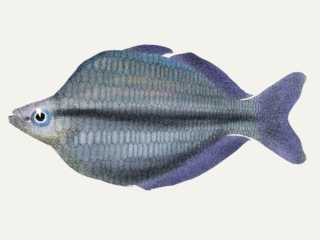
Melanotaenia kamaka, the Kamaka rainbowfish is a species of rainbowfish in the subfamily Melanotaeniinae. It endemic to southwest New Guinea, specifically lake Kamakawaiar of which it earns its name.













